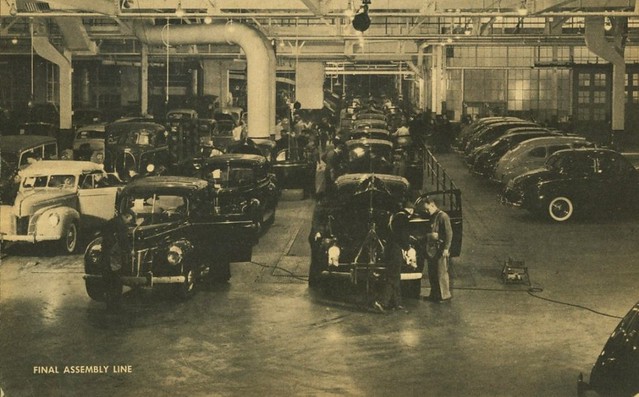 Vaclav Smil examines the rise and fall of American manufacturing dominance in this recent book. He advocates a return to home production, arguing that outsourcing and globalization have concentrated gains to a small group of individuals making it increasingly difficult for the U.S. to compete with rising powers. Smil thinks America can rise to the enormous challenge before it, but is not optimistic about its desire to do so, writes Steve Coulter. Recommended to those studying manufacturing, technology, and the economy.
Vaclav Smil examines the rise and fall of American manufacturing dominance in this recent book. He advocates a return to home production, arguing that outsourcing and globalization have concentrated gains to a small group of individuals making it increasingly difficult for the U.S. to compete with rising powers. Smil thinks America can rise to the enormous challenge before it, but is not optimistic about its desire to do so, writes Steve Coulter. Recommended to those studying manufacturing, technology, and the economy.
 Made in the USA: The Rise and Retreat of American Manufacturing. Valclav Smil. MIT Press. September 2013 .
Made in the USA: The Rise and Retreat of American Manufacturing. Valclav Smil. MIT Press. September 2013 .
American manufacturing created the world’s biggest economy and it’s first truly prosperous mass consumption society. Its industrial power fostered a long lasting image of the US as a land of accomplishment and opportunity. However, if the US is going to go head to head with rising power China then it needs to solve a daunting set of problems.
Chief among these are dealing with vast budget and trade deficits, bringing down unemployment and properly educating a much greater proportion of its workforce than it does at present. Perhaps of equal importance is overturning corrosive attitudes which hold that manufacturing doesn’t matter any more. The notion that ‘serving potato chips is the same as making micro-chips’, as author Vaclav Smil, paraphrases it, bears much responsibility of politicians’ tolerance of firms relocating their manufacturing activities to cheaper developing countries, and also to their relaxed attitudes over how much tax these pay on sales of the finished products when these are shipped back to the US.
The facts speak for themselves. America entered the twenty-first century with 17m manufacturing workers: by the end of the last decade, 5.7m of these jobs had gone. Manufacturing’s share of GDP has plunged from 27% in 1950 to 13.5% in 2010. The US has consistently run trade deficits since 1976, rising to $500bn in 2010. There is no reason for it to do so – as the world’s biggest economy it has a large enough domestic market to satisfy its wants and needs from mainly home production. But America has bought in heavily to the idea that globalization will lift all boats, when the reality, according to Smil, is that most of its spoils go to the few.
As a key source of well-paid, secure middle class jobs, the decline of manufacturing is therefore increasingly implicated in the stark and worsening figures for income inequality and poverty in America. The whole US economy stutters when manufacturing misfires, as most R&D is conducted within, or for, manufacturing firms and its product development activity drives the most productive sectors of the economy, including services.
How did America – which has been the world’s trend-setting economy for over a century – get into this mess? Smil tries to answer this question by providing a broad history of America’s industrial rise and stagnation. He then attempts to explain why over the last 30 years it has thrown away so many of its of advantages. His approach is data-laden, but not particularly technical and should appeal to the lay reader.
America’s manufacturing dominance for the last part of the nineteenth century and the bulk of the twentieth was built on vast natural resources, a large and increasingly prosperous population oriented towards consumption, and the ingenious and effective application of mass production techniques to factory work.
Following its Civil War, America quickly overtook Britain as the workshop of the world and was soon closing in on German levels of total factor productivity with a series of technical innovations which transformed how things were made. But the demand side of the story is also crucially important. Smil scotches the idea that America’s efforts in the two World Wars were primarily responsible for its industrial leadership by pointing to the relentless rise of consumer society, which provided a ready market for cheap, mass produced household goods and enabled American firms to exploit vast economies of scale.
The Ford Motor Company exemplified this. Henry Ford built the world’s largest manufacturing plant at River Rouge in Dearborn in 1917 and at its peak 100,000 people worked there building cars. The Ford system was built on an unprecedented level of vertical integration, with virtually all components built in-house. It initially relied on building a single, unchanging model to control costs, but by the 1920s Ford was making model alterations annually. Ford cars were deliberately priced to be affordable by its workers, providing a captive source of demand for its products and spurring the idea of continual product development.

Plant managers searched relentlessly for lower costs. Frederick Taylor began looking systematically for reasons why tools kept breaking, but his investigations led to new ‘scientific’ rules for optimizing labour productivity which are still applied today. Smil, who has a scientific and environmentalist background himself, also cites cheap energy and raw materials as lying behind America’s early advantages in manufacturing. In the days before OPEC and global competition for raw materials, firms were able to control costs by carefully managing input prices and seeking ever greater scale.
Things took a turn for the worse in the 1970s. Oil prices quadrupled and emerging manufacturing powers, such as the resurgent Japan, began making serious inroads into American markets with what were, quite frankly, superior products. The fate of the Detroit carmakers is a case in point. Ford, GM and Chrysler produced shoddy, unsafe and expensive vehicles, and repeatedly abandoned half-hearted attempts to make them more fuel efficient whenever the oil price fell. The bailouts of GM and Chrysler in 2010 were merely the latest humiliation. The ‘Big Three’ limp, but for how long?
Smil is equally scathing on the myth of US leadership in high-technology. While US firms commercialise a disproportionate share of advanced technology products the country enjoys few of the benefits, running a miniscule trade surplus in these high-value goods. Most of the semi-conductor business has long since shifted to Asia and other hi-tech firms have offshored as much of their activity as possible for gains that seem minimal to anyone but their shareholders and senior managers. Apple, for example, could easily produce the iPhone in the US as labour costs, while much higher there, are still a tiny percentage of the total production costs. Making as well as selling the iPhone in the US would cut Apple’s profit margin from 64% to ‘only’ 50%, Smil argues. By ‘onshoring’ iPhone production Apple could continue making handsome profits while creating many good jobs in its home market.
Can America Inc. be saved? Smil thinks so, but is not particularly optimistic. It needs a change of political will to put the health of manufacturing before remuneration of shareholders and chief executives, and to prioritise production and employment ahead of debt and consumption. America has met these kinds of challenges before, but can it do so again?
——————————————
Steve Coulter is a Research Officer at the LSE’s European Institute (EI). Prior to joining the EI, Steve was a Research Fellow at City University and adjunct lecturer in comparative political economy at the Clore Management School, Birkbeck College, London. He is also an Associate Fellow of the Social Market Foundation think-tank and previously worked for BBC News as a Senior Economics Analyst. He was awarded his PhD from the European Institute in 2011 for a thesis on the political strategies of trade unions in liberal market economies, and also has a BA in history from King’s College, Cambridge. Read reviews by Steve.







